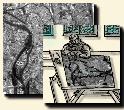 |
 |
Perceptual Grouping
![]()
ALQUIER and MONTESINOS in their article [L. Alquier, 1996] present a method to group and assemble the linear primitives, on SPOT images, by means of a method of dynamic programming comparable to active contours.
They raise the problem of the non convexity of the images due to noise and the need for initializing the edges close to real edge, to avoid divergences. They propose a method of dynamic programming which behaves partly like an active contour in term of energies. The influence of the context and the curve themselves condition its evolution towards an optimal solution. The aggregation of the primitives uses a function of quality, then optimizes this function from local level to global level. The groups thus carried out are selected in a semi-automatic way according to their quality.
The function of quality is composed of four terms, functions of:
The linear combination of these terms makes it possible to modulate the total behaviour of the curve and thus to adapt it to the type of the object searched.
For each point P, two points in a more or less distant neighbourhood are selected. They condition the arrival and the possible departure of a curve going through P. The pair giving the best value of quality is selected. The recursive expression of the function of quality calculates a local contribution around P, and the contribution of the values of the neighbours, a total contribution.
Thus, the influence of the noise and the holes between lineaments are minimized. As the method is not symmetric, this operation is carried out in the two directions of the curve path.
The extent of the neighbourhood makes it possible to regulate the degree
of globality of the method. In return, the curve has a lower degree of
detail.